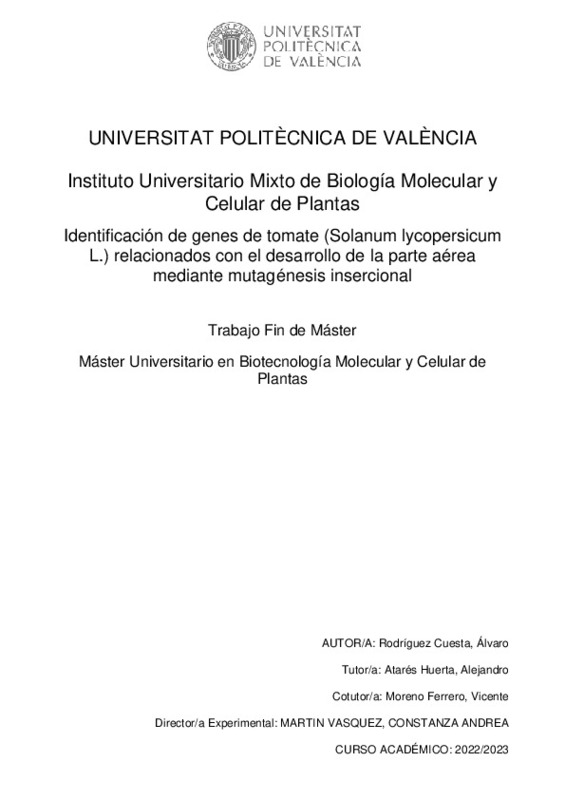|
Resumen:
|
[ES] El tomate (Solanum lycopersicum L.) es una de las hortalizas más producidas y consumidas a nivel mundial y desde su domesticación en América del Sur y Central ha sido empleado por multitud de culturas. Pero su uso no ...[+]
[ES] El tomate (Solanum lycopersicum L.) es una de las hortalizas más producidas y consumidas a nivel mundial y desde su domesticación en América del Sur y Central ha sido empleado por multitud de culturas. Pero su uso no solo se limita a la alimentación, ya que el tomate es una especie muy usada en la investigación por sus características, como su facilidad de cultivo y la producción de un fruto carnoso. El cultivo in vitro es una herramienta clave en la investigación vegetal, ya que permite la obtención de plantas mutantes y el estudio de diferentes procesos, como la morfogénesis. Para favorecer su obtención se puede hacer uso de técnicas de mutagénesis, como la mutagénesis insercional, con trampas génicas. Por ello, el objetivo de este trabajo es la evaluación de plantas de tomate mutantes obtenidas mediante mutagénesis insercional y alteradas en el desarrollo de la parte aérea. Se presentan los resultados de seis líneas diferentes de mutantes de tomate. Todas estas líneas, previamente identificadas en nuestro grupo, presentan un fenotipo de menor desarrollo de la parte aérea, con una menor elongación del tallo que los controles wild type. En ellas se ha estudiado su desarrollo en condiciones in vitro e in vivo, además de su capacidad de regeneración adventicia. También se determinó el modo de herencia de la mutación, el número de insertos presentes y el posible fenómeno de cosegregación entre el inserto y la mutación. La finalidad última de estas líneas es la identificación del gen afectado por la mutación.
[-]
[EN] Tomato (Solanum lycopersicum L.) is one of the most produced and consumed vegetables worldwide and since its domestication in South and Central America, it has been used by plenty of cultures. However, its use is not ...[+]
[EN] Tomato (Solanum lycopersicum L.) is one of the most produced and consumed vegetables worldwide and since its domestication in South and Central America, it has been used by plenty of cultures. However, its use is not only limited to food, as tomato is a species widely used in research due to its characteristics, such as its ease of cultivation and the production of a fleshy fruit. In vitro culture is a key tool in plant research, since it allows obtaining mutant plants and studying different procesess, such as morphogenesis. In order to obtain mutant plants, mutagenesis techniques can be used, for example insertional mutagenesis via enhancer traps. Therefore, the main objective of this work is the evaluation of tomato mutant plants obtained by insertional mutagenesis and altered in the development of the aerial part. The results of six different tomato mutant lines are presented. All this lines, previously identified in our group, show a phenotype of less aerial part development, with less stem elongation, than the wild type controls. Their development under in vitro and in vivo conditions has been studied, as well as their capacity for adventitious regeneration. The way of inheritance of the mutation, the number of inserts present and the possible cosegregation phenomenon between the insert and the mutation were also determined. The ultimate purpose of these lines is to identify the gene affected by the mutation.
[-]
|







